Prepare to relax and unwind with Miyabi as you build your Japanese garden from the ground up!
No green thumb required!

What is Miyabi?
Miyabi is a tile placement game where players will attempt to build the most beautiful Japanese garden. Players will draft tiles to place onto their boards, building upwards as the game progresses. The higher you build the more points your tiles will earn.
How do you play?
First you’ll set up the game so it looks a little something like this:

Each player will take a player mat, and 6 wooden lanterns in their player color, placing these above their mat.
The game takes place over several building rounds. The number of rounds is determined by the number of players with all of this information easily accessible and printed directly onto the score board.
At the start of each round, you will place a number of garden tiles (based on number of players) into the center of the table following the info card which tells you how many of which type you will need. The rest of the tiles remain face down in the box.
Placing a Garden Tile
On the tiles are depicted one of 6 different types of objects. Each row in your garden can only contain one type of object as shown on the left side of you board.
On your turn you will either select and place a garden tile or pass if you cannot play any of the tiles available.
When you select a tile to place in your garden, you must make sure the object on the tile is in the correct row and within the 6×6 square grid. After you place a tile, you will then place one your lanterns in the lantern field for the column you just placed the object in. Subsequent tiles that you place in your garden for that round cannot have their object in that column. (The empty green spaces may lay in any row or column.)

After placing your tile and moving your lantern, you immediately receive points for the tile you placed equal to the number of objects on the garden tile multiplied by the layer you placed it.
(For example: The tile pictured above would receive 2 x 3 for 6 points. 2 for the two red maple trees on the tile, times 3 for being on the third level.)
Play proceeds around the table until all players have either filled all their lantern fields with lanterns or have passed. This ends the building round. Unused tiles are removed from the game, the building round marker is moved one space, players move their lanterns back above their board, and new garden tiles are placed out for the next building round.
For each object type, there is one bonus tile that is awarded to the first player who places a garden tile with that object on the fifth layer. They earn that many points immediately.
Game End and Included Expansions
Once the final building round has ended, players complete final scoring. Players can earn points for having the most visible objects of each type in each row, scoring each row individually. Then the player with the most points wins.
Included with Miyabi are 5 mini-expansions. These can be added individually or mix/matched/combined in any manner players may prefer.

What do we think?
We have really enjoyed Miyabi. It has a calming quality about it that I really like. It is a nice puzzle to plan and work through and I love when a game takes things vertical; it’s a different way of working with a game than you’re used to. In this way it reminds me of the other vertical puzzle game in our collection NMBR9.
Playing Miyabi is not unlike walking through a garden. It’s nice and enjoyable but probably isn’t going to rank high on your list of exciting activities during your lifetime. That isn’t to say that Miyabi isn’t good, its a very nice game, it just isn’t a super exciting game. There aren’t any “wow” moments that happen. From turn to turn, the game feels the same so if you prefer more of a rollercoaster ride with lots of ups, downs and filled with exciting moments, you won’t find that here.
I like that Miyabi is an easy game to teach and very inviting to new players. This is one that I can introduce to anyone and know they’ll be able to catch on and play with confidence. It’s a great family game in that since as it is easily grasped and can be enjoyed by a wide age range during the same game.

Theme
The theme doesn’t really matter in terms of game play, Miyabi is an abstract game and could have had any theme put on it. That being said, the zen garden angle works for the overall feel created while playing. It takes careful planning to build a beautiful and meticulous garden and that is exactly what you’ll have to do in order to win.
I am always on the look out for calming and relaxing games to play in the evenings. Some nights I just need to wind down after the whirlwind of raising these cute babies all day and Miyabi is perfect.
My favorite way to play is to turn on some zen/spa like background music to create some nice atmosphere. Honestly, it is so lovely playing this way and enhances the experience so much that I recommend you do so as well!
Components
The components are very nice and the game comes with a lot of plastic bags to help keep everything organized and tidy to help with both set up and storage. While the game is beautiful, it’s just lacking a bit of the pizazz that could help catapult it into people’s hearts like Kiesling’s abstract super hit Azul.

The first thing I noticed though that took me by surprise was the paper playing mat. I have some mixed feelings on this.
First and foremost I’m concerned about the wear these paper mats will be able to withstand. You will want absolutely no water or food around this game. If you missed a drop of water on the table and were to set your mat on it there would be no recovering. Typically HABA uses really high end materials and thick cardboard for player mats, (like the ones in Honga!) So the thin and flimsy nature of these left me a little disappointed.
There is a possibility that the paper works better since you don’t have to worry about warp and uneven player mats. Because you are stacking pieces on top of each other, you need your mat to lay flat and not spin or jostle easily. The paper mats work in this respect.
Be that as it may, I still worry about how long these will last and ultimately wish that they felt a little bit more high end. If you like to play with a drink and snacks nearby (I do!) you’ll want to be extra careful.
Everything else is very nice though not spectacular. The game’s art is pretty good but a bit on the dull side when printed onto the polyomino pieces. This doesn’t impact my play experience or the game, I just wish it would have been a bit more vibrant like the box cover which is utterly gorgeous. Admittedly, this is a bit nit-picky, but they’re my thoughts nonetheless.

I really appreciate that they included so many extra expansions to keep players challenged and the game interesting. These “expansions” are truly more like variants rather than expansions. They are just different ways to play the game that either increases the challenge or provides a different puzzle element. The best part is you can add which one(s) you’d like to play with and easily remove them when you’d rather not. This makes teaching Miyabi to new players incredibly easy; once they’ve got their first game under their belt, you can add in a variant if desired. Very nice.
How does it play with two?
Miyabi works well with two. This is the kind of game that we really enjoy playing together on quiet evenings after the kids have gone to bed.
I might prefer the game with the full four slightly better though. This is because you have more garden tiles that are available to you so there’s a better chance of being able to get what you’d like or course correct when the other players take something you had your eye on.
In a two player game, because there are fewer pieces available, it is much easier to see what pieces your opponent needs most, meaning that there can be more spiteful drafting which some will not enjoy.
We felt your game also relies far more on luck in a two player game than a full four. Because there are so few pieces that will become available each round, you’re really hoping luck is on your side each time you add more tiles.
Can kids play?
As far as kids are concerned, this is a nice option for families to play together and is perfectly suited for the 7 or 8 year old child.
Kids will learn the importance of planning ahead and being able to change course. Learning how to place tiles to help set you up for another placement a turn or two later will be a challenge at first, but a good spacial skill kids can work on.
Alice really enjoyed this game and did a nice job of working through the puzzle of it all. The game was a bit too much for our son though, at 5 this is a touch beyond what he’s able to enjoy playing so definitely steer more towards 8 years of age on this.
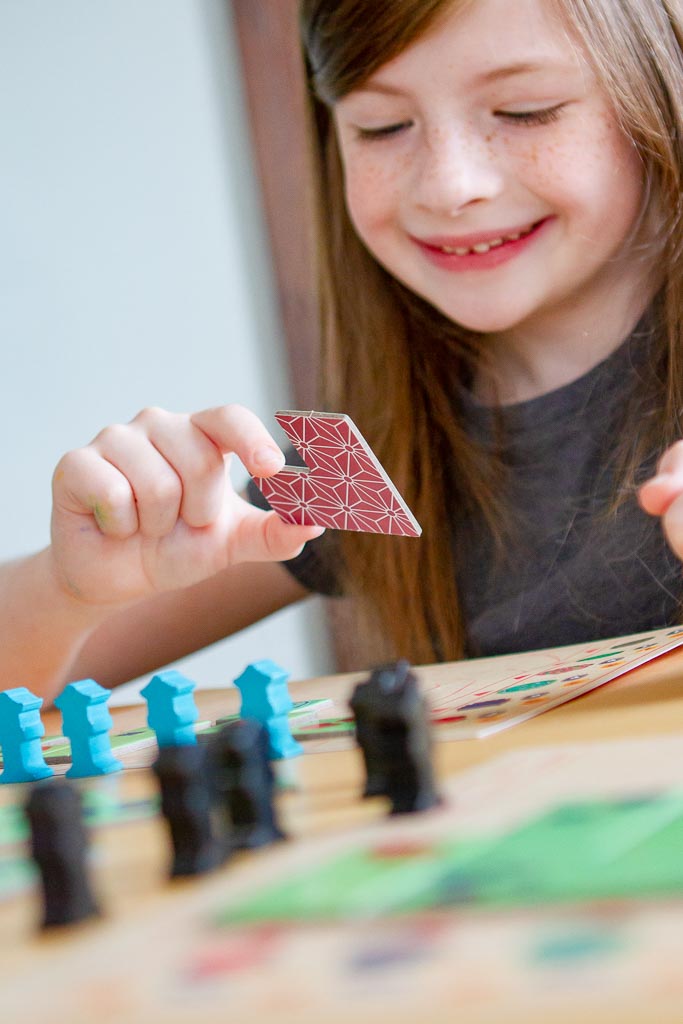
Summary
Miyabi is a lovely game that will delight fans of abstract games with puzzle elements. With streamlined play and multiple variants to try, you will be able to learn and play Miyabi quickly and enjoy playing it again and again as you find new ways to plan and grow your garden.
The vertical element and tricky placement limitations provides a fun puzzle for players to work through as they try to not only expand their garden out but up and must find ways to build upon layers to earn the most points.
While there aren’t any exciting moments in the game, Miyabi has a nice relaxing playing experience that is perfect for when you are looking for a calm game to enjoy that will challenge you without burning your brain.
Game Info:
Title: Miyabi
2-4 Players Ages 8+
Designer: Michael Kiesling
Artist: René Amthor
Publisher: HABA
A special thank you to HABA for sending us a copy of Miyabi for review.
As always, our thoughts and opinions are our own.



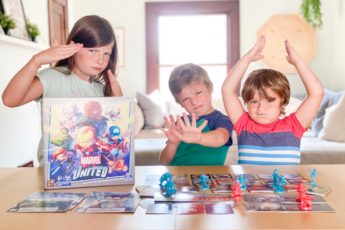
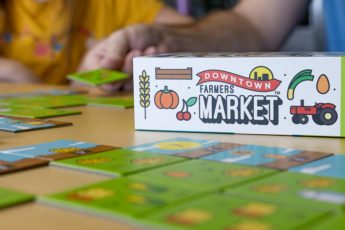
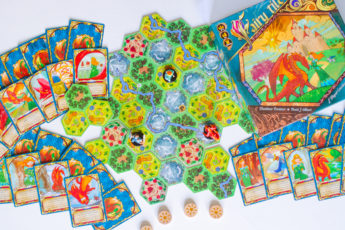





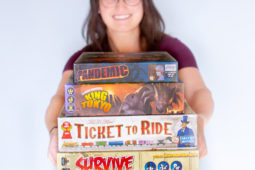
Leave a Comment